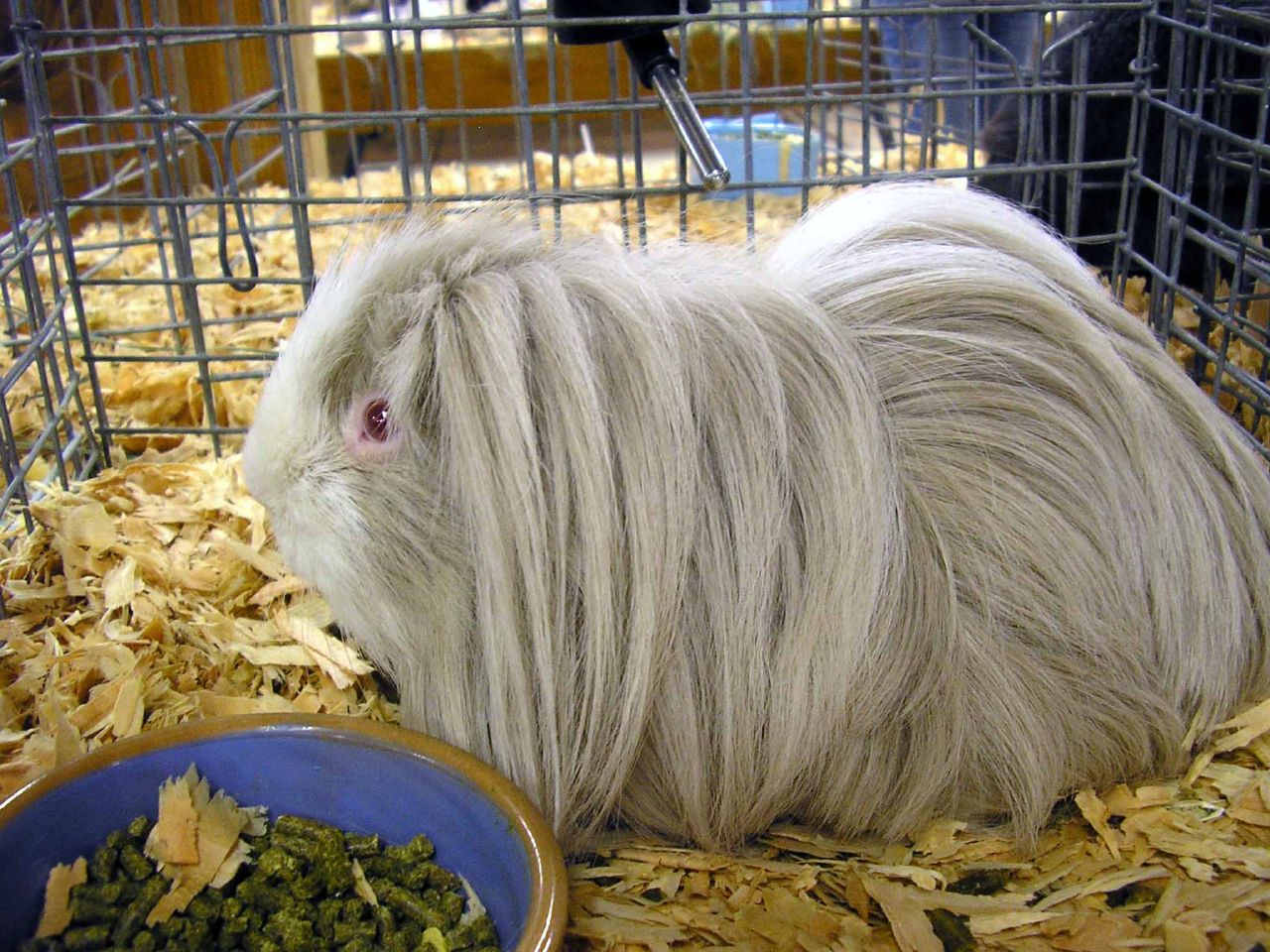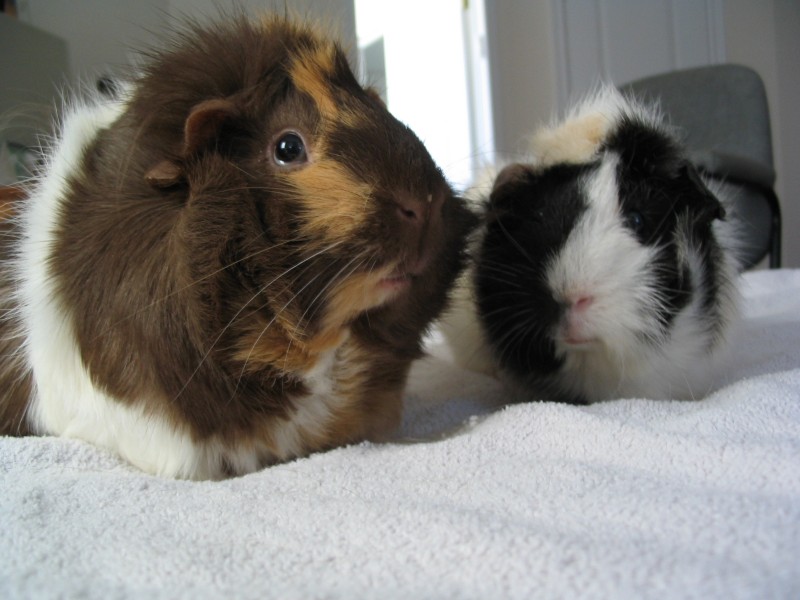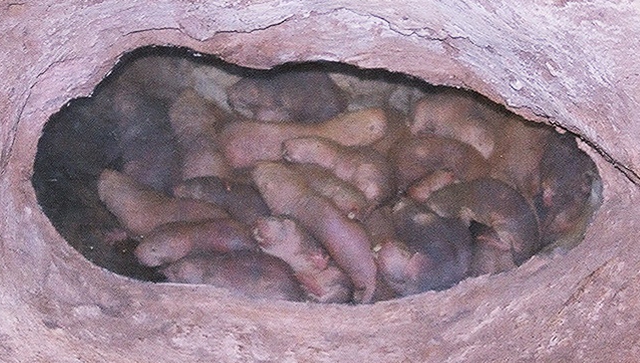|
Baldwin Guinea Pig
The Baldwin guinea pig is a breed developed from a spontaneous genetic mutation in Carol Miller's show-line of white crested golden agouti. Though born fully furred, Baldwin guinea pigs begin to lose their fur at two to five days of age, starting at the nose and leaving them almost entirely hairless by about two months of age. They retain whiskers and sometimes a few hairs on their feet. Baldwins are known for having skin of a rubbery texture, many wrinkles and large, droopy ears. They come in all colors and patterns that haired guinea pigs come in, such as Dutch, tortoiseshell, broken colors, Himalayan and selfs. Unique traits Hairless guinea pigs are not significantly physiologically different than regular haired guinea pigs, although they need to eat more to maintain body heat. The optimal temperature range for a hairless guinea pig is , which is slightly higher than the optimal temperature range for the haired guinea pig. Their skin has a similar appearance to human ... [...More Info...] [...Related Items...] OR: [Wikipedia] [Google] [Baidu] |
Guinea Pig
The guinea pig or domestic guinea pig (''Cavia porcellus''), also known as the cavy or domestic cavy (), is a species of rodent belonging to the genus ''Cavia'' in the family Caviidae. Breeders tend to use the word ''cavy'' to describe the animal, while in scientific and laboratory contexts, it is far more commonly referred to by the common name ''guinea pig''. Despite their common name, guinea pigs are not native to Guinea, nor are they closely related biologically to pigs, and the origin of the name is still unclear. They originated in the Andes of South America. Studies based on biochemistry and hybridization suggest they are domesticated animals that do not exist naturally in the wild, descendants of a closely related cavy species such as '' C. tschudii''. They were originally domesticated as livestock for a source of meat, and are still consumed in some parts of the world. In Western society, the guinea pig has enjoyed widespread popularity as a pet since its introducti ... [...More Info...] [...Related Items...] OR: [Wikipedia] [Google] [Baidu] |
Guinea Pig Breed
There are many breeds of guinea pig or cavy which have been developed since its domestication circa 5000 BCE. Breeds vary widely in appearance and purpose, ranging from show breeds with long, flowing hair to laboratory breeds being used as model organisms for science. From roughly 1200 to 1532 CE (during the Spanish conquest of the Inca Empire), selective breeding by indigenous South American people resulted in many landrace varieties of domestic guinea pigs, which form the basis for some formal modern breeds. Early Andean varieties were primarily kept as agricultural stock for food, and efforts at improving cavy breeds (''cuy'') bred for food continue to the modern era, with entirely separate breeds that focus on size and disease resistance. With the export of guinea pigs to Europe in the 15th century, the goal in breeding shifted to focus on the development of appealing pets. To this end, various competitive breeding organizations were founded by fanciers. The American Cavy ... [...More Info...] [...Related Items...] OR: [Wikipedia] [Google] [Baidu] |
List Of Guinea Pig Breeds
There are many breeds of guinea pig or cavy which have been developed since its domestication circa 5000 BCE. Breeds vary widely in appearance and purpose, ranging from show breeds with long, flowing hair to laboratory breeds being used as model organisms for science. From roughly 1200 to 1532 CE (during the Spanish conquest of the Inca Empire), selective breeding by indigenous South American people resulted in many landrace varieties of domestic guinea pigs, which form the basis for some formal modern breeds. Early Andean varieties were primarily kept as agricultural stock for food, and efforts at improving cavy breeds (''cuy'') bred for food continue to the modern era, with entirely separate breeds that focus on size and disease resistance. With the export of guinea pigs to Europe in the 15th century, the goal in breeding shifted to focus on the development of appealing pets. To this end, various competitive breeding organizations were founded by fanciers. The American Cav ... [...More Info...] [...Related Items...] OR: [Wikipedia] [Google] [Baidu] |
Guinea Pig
The guinea pig or domestic guinea pig (''Cavia porcellus''), also known as the cavy or domestic cavy (), is a species of rodent belonging to the genus ''Cavia'' in the family Caviidae. Breeders tend to use the word ''cavy'' to describe the animal, while in scientific and laboratory contexts, it is far more commonly referred to by the common name ''guinea pig''. Despite their common name, guinea pigs are not native to Guinea, nor are they closely related biologically to pigs, and the origin of the name is still unclear. They originated in the Andes of South America. Studies based on biochemistry and hybridization suggest they are domesticated animals that do not exist naturally in the wild, descendants of a closely related cavy species such as '' C. tschudii''. They were originally domesticated as livestock for a source of meat, and are still consumed in some parts of the world. In Western society, the guinea pig has enjoyed widespread popularity as a pet since its introducti ... [...More Info...] [...Related Items...] OR: [Wikipedia] [Google] [Baidu] |
Skinny Pig
The Skinny pig or skinny is an almost hairless strain of guinea pig. Skinny pigs typically have hair on their muzzles, feet, and legs, but are hairless over the remainder of their bodies. Some of them have a thin covering of fuzzy hair on their backs as well. The Skinny pig is not one of the 13 recognized cavy breeds by the American Cavy Breeders Association. A healthy skinny has skin that is mostly smooth, with some wrinkling around the legs and neck. The body is full with no appearance of spine or ribs. Skinnies can come in a variety of skin colors and patterns, including "Dutch", "Brindle", and " Himalayan". The term "skinny" is used for hairless guinea pigs either because it colloquially refers to the exposed skin of the animal, or because it describes their thinner appearance due to their lack of hair. The modern strain of skinny pig originated from a cross between haired guinea pigs and a hairless lab strain. The hairless strain that it is most likely related to was a s ... [...More Info...] [...Related Items...] OR: [Wikipedia] [Google] [Baidu] |
Recessive Gene
In genetics, dominance is the phenomenon of one variant (allele) of a gene on a chromosome masking or overriding the effect of a different variant of the same gene on the other copy of the chromosome. The first variant is termed dominant and the second recessive. This state of having two different variants of the same gene on each chromosome is originally caused by a mutation in one of the genes, either new (''de novo'') or inherited. The terms autosomal dominant or autosomal recessive are used to describe gene variants on non-sex chromosomes ( autosomes) and their associated traits, while those on sex chromosomes (allosomes) are termed X-linked dominant, X-linked recessive or Y-linked; these have an inheritance and presentation pattern that depends on the sex of both the parent and the child (see Sex linkage). Since there is only one copy of the Y chromosome, Y-linked traits cannot be dominant or recessive. Additionally, there are other forms of dominance such as incomplete d ... [...More Info...] [...Related Items...] OR: [Wikipedia] [Google] [Baidu] |
Caviinae
Caviinae is a subfamily uniting all living members of the family Caviidae with the exception of the maras, capybaras, and ''Kerodon''. The subfamily traditionally contained the guinea pig or cavy-like forms along with the cursorially adapted (running) ''Kerodon''. Molecular results suggest the Caviinae as so defined would be paraphyletic and ''Kerodon'' is more closely related to maras and capybaras than to other caviines.Rowe, D. L. and R. L. Honeycutt. 2002. Phylogenetic relationships, ecological correlates, and molecular evolution within the Cavioidea (Mammalia, Rodentia). Molecular Biology and Evolution, 19:263-277. This led Woods and Kilpatrick (2005) to unite ''Kerodon'' and capybaras into the subfamily Hydrochoerinae within the Caviidae. These studies also suggest ''Microcavia'' and ''Cavia'' are more closely related to one another than either is to '' Galea''. Genera and species *Subfamily Caviinae **†'' Cardiomys'' **†'' Allocavia'' **†'' Palaeocavia'' **†'' ... [...More Info...] [...Related Items...] OR: [Wikipedia] [Google] [Baidu] |
Nude Mouse
A nude mouse is a laboratory mouse from a strain with a genetic mutation that causes a deteriorated or absent thymus, resulting in an inhibited immune system due to a greatly reduced number of T cells. The phenotype (main outward appearance) of the mouse is a lack of body hair, which gives it the "nude" nickname. The nude mouse is valuable to research because it can receive many different types of tissue and tumor grafts, as it mounts no rejection response. These xenografts are commonly used in research to test new methods of imaging and treating tumors. The genetic basis of the nude mouse mutation is a disruption of the FOXN1 gene. Nomenclature The nomenclature for the nude mouse has changed several times since their discovery. Originally they were described as ''nu'' and this was updated to ''Hfh11nu'' when the mutated gene was identified as a mutation in the HNF-3/forkhead homolog 11 gene. Then in 2000 the gene responsible for the mutation was identified as a member of th ... [...More Info...] [...Related Items...] OR: [Wikipedia] [Google] [Baidu] |
Naked Mole-rat
The naked mole-rat (''Heterocephalus glaber''), also known as the sand puppy, is a burrowing rodent native to the Horn of Africa and parts of Kenya, notably in Somali regions. It is closely related to the blesmols and is the only species in the genus ''Heterocephalus''. The naked mole-rat exhibits a highly unusual set of physiological and behavioral traits that allow it to thrive in a harsh underground environment; most notably its being the only mammalian thermoconformer with an almost entirely ectothermic (cold-blooded) form of body temperature regulation, as well as exhibiting a complex social structure split between reproductive and non-reproductive castes, making it and the closely-related Damaraland mole-rat (''Fukomys damarensis'') the only widely recognized examples of eusociality (the highest classification of sociality) in mammals. The naked mole-rat lacks pain sensitivity in its skin, and has very low metabolic and respiratory rates. It is also remarkable for its l ... [...More Info...] [...Related Items...] OR: [Wikipedia] [Google] [Baidu] |




